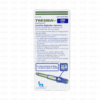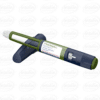The 2x Referral Bonus Event Is Now On! More Info ➡️
SAVE 10% OFF First Order With Coupon Code: WELCOME10


Our Price: $179.99

Step 1
Place Your Prescribed Tresiba (200) FlexTouch Pens Dosage In Your Cart
Step 2
Complete Checkout
Step 3
Upload Your Tresiba (200) FlexTouch Pens Prescription
(Shipping takes approximately 4-10 business days. A tracking number will be provided)
Tresiba FlexTouch Pens 200 can cause severe hypoglycemia, leading to seizures, unconsciousness, and death. Patients should be closely monitored for signs of hypoglycemia, and their insulin dosage should be carefully adjusted. The medication should only be used under the supervision of a healthcare provider.
Consult your doctor before using Tresiba and be aware of the following:
Hypoglycemia (low blood glucose levels) – if your blood sugar levels drop too low, be sure to follow your doctor’s instructions
Hyperglycemia (high blood glucose levels) – follow your doctor’s instructions if your blood sugar levels are too high
Switching between insulin medications – your insulin dose may need to be adjusted if you change brands or another type of insulin.
Ensure you are using the correct type of insulin – always check the label before administering medication. You can easily mistake Tresiba Flextouch with Fiasp Flextouch or NovoLog Flextouch.
Eye disorders – fast improvements in blood sugar control may lead to potential eye disorders such as diabetic retinopathy. Consult with your doctor if you have any vision problems.
Tresiba is not recommended for treating diabetic ketoacidosis.
Do not use Tresiba if you are allergic to insulin degludec or any of the ingredients in this medication.
Rotate injection sites regularly to avoid skin complications such as shrinking, thickening, or developing lumps under the skin.
Injecting insulin into lumpy skin, shrunken or thickened skin may affect the effectiveness of Tresiba. Inform your doctor if you are injecting into affected areas as they may choose to recommend closely monitoring your blood glucose levels, adjusting your insulin dosage, and other antidiabetic medications (such as Ozempic or Saxenda). Be sure to inform your doctor of any and every medication you are currently taking.
Tresiba can be used in children over the age of 1 and adolescents.
The following may cause hypoglycemia: other diabetes medications (oral or injectable), sulfonamides, for infections, anabolic steroids (such as testosterone), beta-blockers (used for high blood pressure), mild fever, monoamine oxidase (MAO) inhibitors, angiotensin-converting enzyme (ACE) inhibitors and acetylsalicylic acid (and other salicylates).
If you are consuming alcohol, you may require adjusting your insulin treatment since alcohol can cause a rapid increase and decrease in blood sugar levels. It’s essential to monitor blood sugar levels if you consume alcohol.
Having low blood sugar levels can affect a patient’s ability to concentrate. This could be dangerous if a patient is driving or operating machinery.
Tresiba is injected subcutaneously (under the skin) once daily, at any time of the day.
Adult patients who notice they’ve missed a dose should inject their daily dose during waking hours then continue their regular dosing schedule.
For pediatric patients, Tresiba should be taken at the same time daily. If they miss a dose, they should contact their doctor and monitor blood sugar levels closely until their next dose.
Adult patients should ensure that at least 8 hours have elapsed between consecutive injections. Dose increases should be made within 3-4 days from the last injection.
It’s important to note that Tresiba contains less than one mmol sodium (23 mg) per dose which means it’s essentially sodium-free.
As with all medication, side effects can occur when taking insulin in regular dosages. Side effects can range from mild to severe. Typically most side effects last go away within a few days or weeks.
Hypoglycemia (low blood sugar) is the most common side effect when taking insulin. It usually affects 1 in 10 people; however, if not treated can become severe.
If you experience low blood sugar, be sure to consume a glucose tablet, sugar snack (such as hard candy, raisins, jelly beans, sugar packet), or beverage (fruit juice or non-diet soda).
If blood sugar levels drop too low, patients can lose consciousness and require a glucagon injection since they cannot take sugar orally. Inform family and friends that you have diabetes and educate them on what to do if you lose consciousness due to hypoglycemia.
If you lose consciousness, you should:
A) Turn you on your side
B) Get medical assistance immediately
C) Not give anything orally (food or drink)
Once you regain consciousness, you should consume a sugary snack or beverage.
If you do not regain consciousness, you should be taken to the hospital or contact emergency response.
If severe low blood sugar is not treated promptly, it may result in severe complications such as brain damage or even death.
Low blood sugar can result from drinking alcohol, exercising too much, eating too little, or skipping a meal.
Warning signs of low blood sugar are common suddenly. These include headache, fast heartbeat, cold sweats, cool pale skin, feeling sick, tiredness, weakness, confusion, anxiety, difficulty concentrating, tremors, feeling hungry, blurred vision, measuring blood sugar levels often, and getting rest. Wait until blood sugar levels have settled.
Let your doctor know if you have lost consciousness due to low blood sugar, have used/received a glucagon injection, you’ve experienced frequent episodes of low blood sugar.
This may be the result of your insulin schedule/timing, diet, and exercise.
Hyperglycemia (high blood sugar levels), high blood sugar levels may result from: eating more and exercising less than usual, drinking alcohol, an infection or fever, rationing insulin or not using enough, skipping insulin doses, stopping using insulin without speaking to your doctor.
Symptoms of hyperglycemia may include flushed skin, feeling sleepy or tired, thirst, loss of appetite, nausea or vomiting, increased urination, dry mouth, fruity or acetone breath, and dry skin.
These symptoms can lead to a severe condition called ketoacidosis, a build of acid in the blood. This happens as a result of the body breaking down fat instead of sugar. If not treated, it can potentially lead to diabetic coma or even death.
If patients experience hyperglycemia, they should test blood sugar levels,
test blood for ketones and urine, get medical assistance immediately.
If you experience any side effects not listed above, report them to your doctor or pharmacist. By reporting side effects, you can help improve safety measures and information on this medication.
Blood glucose may rise due to the following drug interactions:
– Anazol (endometriosis)
– Oral contraceptives (birth control pills)
– Thyroid hormones (thyroid problems)
– Growth hormone (growth hormone deficiency)
– Glucocorticoids (i.e., cortisone’ for inflammation)
– Sympathomimetics (i.e., epinephrine, salbutamol, or terbutaline)
– Thiazides (used for high blood pressure or water retention)
– Octreotide and lanreotide (treats acromegaly) and may increase or decrease blood sugar levels.
– Pioglitazone (often used to treat type 2 diabetes)
Consult your doctor immediately if you are experiencing symptoms of heart failure such as rapid weight gain, unusual shortness of breath, or localized swelling (edema).
Inform your doctor if you are currently taking any other prescription medications, over-the-counter drugs, herbal supplements, or vitamins. These may affect glycemic levels, which will require your doctor to adjust your insulin treatment.
It is unknown whether Tresiba affects a baby during pregnancy or breastfeeding. Inform your doctor if you are pregnant, considering pregnancy, breastfeeding, or about to breastfeed. Your doctor may choose to adjust your insulin treatment depending on the patient’s needs. Monitoring blood sugar levels (hypoglycemia) is extremely important as it may affect the health of both mother and baby.
Keep the medication away from children and pets.
Do not use the medication after the expiry date on the label or carton.
Before first use:
Store Tresiba FelxTouch pens in the refrigerator between 36°F to 46°F. Keep the pen on to protect from direct light and away from freezing elements.
After first use or if carried as spare:
You can carry your Tresiba FlexTouch pens with you and keep at away from light or within room temperature (not above 86°F). It can be refrigerated between 36°F to 46°F for up to 8 weeks (56 days).
Be sure to keep the cap on the pen at all times when not in use to protect it from direct light.
Do not dispose of medication in household trash or wastewater (toilet, sink). Speak to your pharmacist about how to properly dispose of medicine no longer used to protect the environment.
At Insulin Outlet, we ensure the safety and quality of our medications, meeting all federal legislation standards. Your order will be dispatched from a reputable licensed Canadian pharmacy, guaranteeing the highest standards of reliability and authenticity. This medication has been approved by Health Canada (Canada's FDA) and is identical to what you would receive in the US, only with Canadian labeling and packaging. We do not sell counterfeit or unauthorized medications. Our discounted medications are shipped directly from Canada to your doorstep, providing a fast and secure delivery experience. To conveniently buy Tresiba (200) FlexTouch Pens online at a significant discount, place your order above or call us at 1-888-238-0872.
